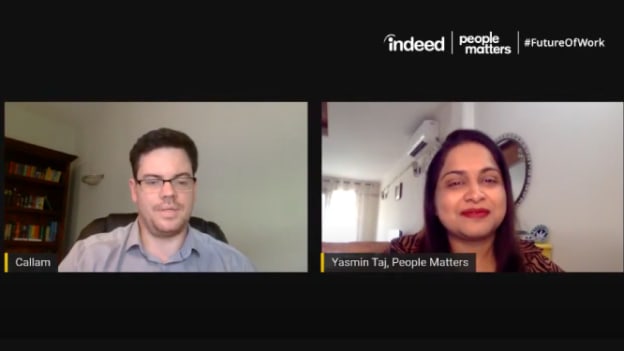2021 Singapore Labor Market Outlook

With historically high unemployment rates and near complete collapse in some industries, this year brought huge unforeseen changes in economic and labor trends. Given that the current condition is quite tense at the moment, how is the job market expected to fare in the coming months? What would be some top jobs that would be in demand in 2021? How many organizations would be open to hiring remote workers?
In the future of work week’s final keynote session on 2021 Singapore Labor Market Outlook, Yasmin Taj, Managing Editor with People Matters, joins Callam Pickering, an Economist at the Indeed Hiring lab with a focus on the Asia Pacific region. With a Bachelor of Economics from Monash University and previous experience working as an economist at the Reserve Bank of Australia as well as an Economic Editor at various publications, he has a rich and diverse history of understanding and translating complicated economics into useful insights. Together, they explore Singapore’s Labor Market - what it is, and what we can expect it to be in the time to come.
Understanding the Context: Recent Market Developments
Any discussion of the future requires a strong understanding of the present. With that in mind, Callam detailed Singapore’s economic context. Everything took a hit during the first few months of the pandemic, beginning in 2020, and there was a recovery phase once the circuit breaker had started to affect the number of cases, both daily as well as overall.
In the recovery, there were three types of industries: strong performers, recovering industries, as well as those that were still struggling. In the first category, there were tech companies, financial services, health, and social services, as well as public administration. Those that were recovering including food and beverage services, professional services, as well as retail trade. And finally, the ones that were struggling were manufacturing, transportation, accommodation, construction, and real estate.
Both goods and services around 50 percent job loss, with half of all jobs lost in manufacturing and construction. But that was only one part of the picture - especially with the recovery phase well underway, private sector surveys suggest that the Singapore labor market is set to improve. While there can be no denying the uncertainty that remains rampant across the entire labor market, a higher share of firms is reportedly intending to expand headcount from as early as Q1 2021. As a result, employment is expected to rise through 2021.
Delving into Insights from Jobs and Jobseekers
Next in line for discussion were the various insights that Indeed, being a hiring platform could provide. Callam had data not only on the jobs that were created (and by whom) but also on the jobs that were in demand, and who was looking for them. There was an expected job loss during the peak of the pandemic, but the recovery phase offered some respite - but in an unexpected manner.
The jobs that were lost during the pandemic were not the ones that were created in the recovery phase. This is true, for example, in food preparation, which reflects a greater need to hire more people in the F&B industry after significant job loss in that segment. With that said, the number of jobs being created in sales, marketing, and accounting was much lesser than what was being created pre-pandemic. The catch here, however, is that just because fewer jobs were being created doesn’t mean that the overall demand had reduced - sales and marketing still accounted for some of the most demand in terms of jobs.
Phrases such as “work from home” and “remote posting” rose rapidly during Singapore's lockdown beginning in April, around the time that the circuit breaker was introduced and it remained high ever since. The current remote posting share is almost three times higher than was normal before the pandemic, signaling not only that employers were looking to hire for remote roles, but also that the interest from talent in remote roles had increased.
But what was it that job seekers were really seeking? One of the key factors was mentioned above: that everyone is looking for a remote role, wherever possible. Moreover, due to the data that Indeed gathers, they also had insight into which job seekers were interested in jobs that had nothing to do with their current or previous roles. In other words, those interested in changing their professions. With COVID restrictions severely impacting the possibility of getting jobs in specific fields - let alone a specific type of work or designation - many prospective employees have considered changing their careers, either temporarily or permanently, depending upon their particular case.
Outlook
From there onwards, Callam turned to Singapore’s economic outlook. The first thing he brought the audience’s attention to was the need to recognize that the outlook for Singapore is still highly uncertain, even though some of these uncertainties have become a little clearer. There is a decent understanding of how dangerous the virus is and how it can be contained. However, there is a lot of uncertainty around the global response on at least two major fronts, including both primary health as well as economic. As a result of the inadequacy of some of these responses, global recovery has been slower, which has affected Singapore’s ability to bounce back as well.
Beyond this, Callam took a closer look at Singapore’s population and linked it to overall insights on hiring and employment in 2021 - including comments on troubling demographics, lower-skilled migration, and much more!














